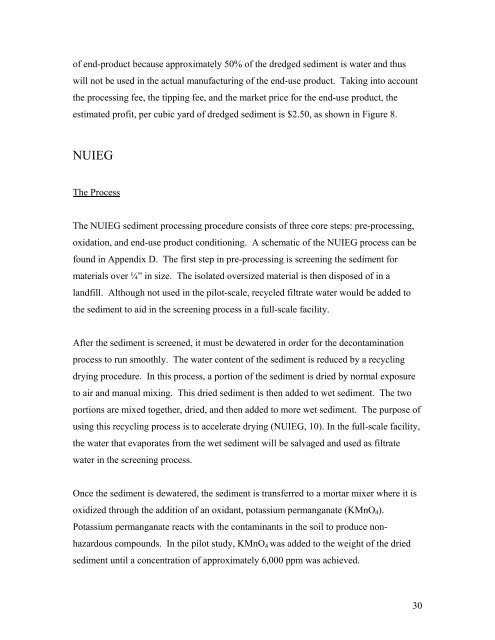New York/ New Jersey Harbor: Alternative Methods for Ex ... - CLU-IN
New York/ New Jersey Harbor: Alternative Methods for Ex ... - CLU-IN
New York/ New Jersey Harbor: Alternative Methods for Ex ... - CLU-IN
Create successful ePaper yourself
Turn your PDF publications into a flip-book with our unique Google optimized e-Paper software.
of end-product because approximately 50% of the dredged sediment is water and thus<br />
will not be used in the actual manufacturing of the end-use product. Taking into account<br />
the processing fee, the tipping fee, and the market price <strong>for</strong> the end-use product, the<br />
estimated profit, per cubic yard of dredged sediment is $2.50, as shown in Figure 8.<br />
NUIEG<br />
The Process<br />
The NUIEG sediment processing procedure consists of three core steps: pre-processing,<br />
oxidation, and end-use product conditioning. A schematic of the NUIEG process can be<br />
found in Appendix D. The first step in pre-processing is screening the sediment <strong>for</strong><br />
materials over ³“ in size. The isolated oversized material is then disposed of in a<br />
landfill. Although not used in the pilot-scale, recycled filtrate water would be added to<br />
the sediment to aid in the screening process in a full-scale facility.<br />
After the sediment is screened, it must be dewatered in order <strong>for</strong> the decontamination<br />
process to run smoothly. The water content of the sediment is reduced by a recycling<br />
drying procedure. In this process, a portion of the sediment is dried by normal exposure<br />
to air and manual mixing. This dried sediment is then added to wet sediment. The two<br />
portions are mixed together, dried, and then added to more wet sediment. The purpose of<br />
using this recycling process is to accelerate drying (NUIEG, 10). In the full-scale facility,<br />
the water that evaporates from the wet sediment will be salvaged and used as filtrate<br />
water in the screening process.<br />
Once the sediment is dewatered, the sediment is transferred to a mortar mixer where it is<br />
oxidized through the addition of an oxidant, potassium permanganate (KMnO4).<br />
Potassium permanganate reacts with the contaminants in the soil to produce non-<br />
hazardous compounds. In the pilot study, KMnO4 was added to the weight of the dried<br />
sediment until a concentration of approximately 6,000 ppm was achieved.<br />
30
















